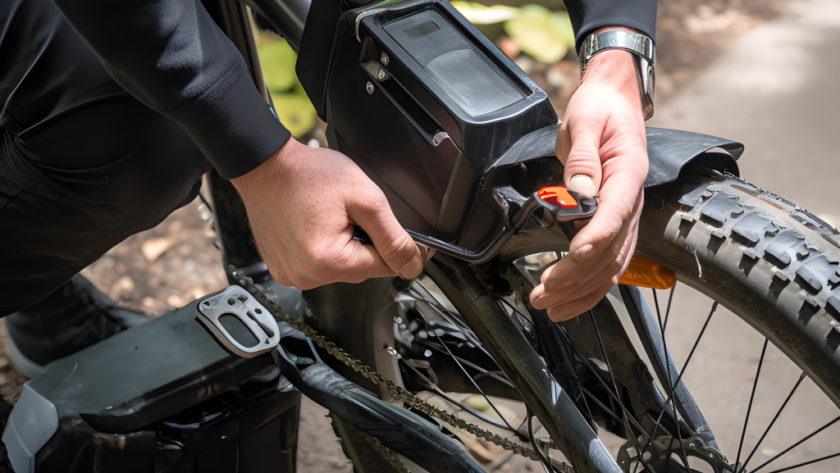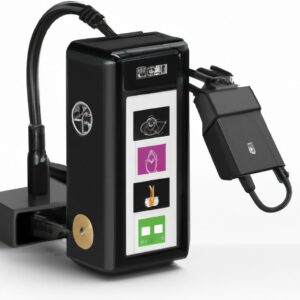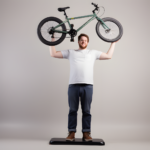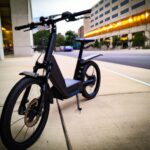What is fast charging and how does it work?
Fast charging is a technology allowing electronic devices to charge at a faster rate than traditional charging methods. This same technology can be applied to an ebike battery as well.
When you plug in your ebike battery to a fast-charger, the charger feeds DC directly to the lithium-ion cells of the battery, with no control circuits, applying a constant voltage. Instead of taking hours, the battery charges in just 30-120 minutes.
So, simply put, fast charging delivers more power to the battery and takes less time to complete the charge cycle.
- It is important to note that not all ebikes can be fast-charged, and not all battery models are compatible.
In addition, the fast charging process must be aligned to charging standards to prevent misuse, since deploying a maladapted fast charge could damage the charging port or even cause irreparable harm to the battery itself.
Fast charging may help you get back to riding quickly if you do a lot of biking and need to recharge multiple times a day, decreasing the overall amount of charging-related downtime. Alternatively, using a conventional charger can take significantly longer generally comprising around 4-6 hours per charge – contrasting 30-120-minute fast charging, respectively.
<! –– End of the section.––>
Difference between Fast Charging and Regular Charging for Ebikes
If you’re an owner of an electric bike, it’s essential to understand the difference between fast charging and regular or slow charging. Regular charging is the conventional way of charging your ebike battery. It takes more extended hours to charge the battery fully.
On the other hand, fast charging is a new technology that promises rapid battery recharge. Fast charging employs higher voltage levels to provide enormous output to charge ebike batteries more quickly.
- In general, fast charging is faster than regular charging, but
- it’s not a good choice as fast charging will have potential drawbacks that we cover shortly
Fast charging works at higher voltage levels, higher temperatures often enabling high power operations in shorter time frames compared with regular charging modes, providing you multiple rides with full throttle.
- We already mentioned it’s faster
With fast charging technology, ebikers won’t need long hours to wait before hopping back onto the bike and setting out on long-distance rides
- It heats up the battery during the charging rush-job. When charging is done with full speed, the temperature level goes higher than if charges slowly.
- The interval charging break might mostly be halved so faster charging technology may lead to cycling performance drops because battery life might not be withheld fully:
- Battery cells have limits to how much they can accept charge capacity up to outer safety limits.
- Batteries weigh more after charging completed Makes the absence of significance in range approximately meaningless non-future electric bike releases’
In conclusion, fast charging appears to be better and faster than slow charging. But this cannot outweigh the safety measures of continuous moderate charging accustomed to methodical temperature checks, finding appropriate chargers in cycle owned items that won’t damage the battery and allowing appropriate downtime between rides.
Advantages & Disadvantages of Fast Charging Your Ebike
Fast charging your eBike can be helpful if you want to quickly charge the battery and hit the road. In contrast, if it is not urgent, then slow charging may be a more reasonable alternative as it will preserve the longevity of your battery over time. Here are the advantages and disadvantages of charging your ebike quickly:
Advantages of Fast Charging:
- Convenience: Quick charging can rapidly and easily recoup the ebike’s battery
- Time-saver: From depleted to full capacity, quick charging can take an average of one to three hours compared with slow charging which can take longer than an entire day.
- Increase Workout Lengths: With rapid top-town solutions, eBikes riders can extend sessions, cycle longer rides, or simply ride more comfortably alongside healthy levels of charge the whole-time.
Disadvantages of Fast Charging:
- Battery Longevity: Utilising fast charging often will inevitably decline the lifespan of the battery, that is if this charging charger feature is abused frequently. However, this wearable nature is common these days as most batteries/gadgets come equipped with rapid charging capacities by default.
- Cost of Battery Life: The very technology speedy working behind fast charging depends on needing a more powerful electricity input than slow/careful charging to get the battery driving fast. This puts limitations on the age and productivity of your battery in comparison with conventional and unhurried charging alternatives.
- Redefined Efficiency: Sometimes the battery efficiency from a rapid charge could imply diminished battery existence cycles over the future adding inconvenience.
For owners of an ebike, fast charging can be a useful and convenient option. However, it does come with its disadvantages. Fast-charging could cause a decrease in battery longevity, charging cycles, and finally affect its functionality. It’s advisable to moderate the use of this feature based on the manufacturer’s recommendations and best practices to maximize long-lasting battery usage.
How to properly use the fast charging feature
Using the fast charging feature on your ebike can be convenient, but it’s important to do it right in order to ensure the longevity of your battery. Here are some tips for properly using the fast charging feature:
1. Check the manufacturer’s recommendation: Some ebike manufacturers may have specific instructions for using the fast charging feature, such as only using it for emergency situations or limiting the frequency of use. Make sure to read the manual or contact the manufacturer for guidance.
2. Don’t overcharge: As with regular charging, overcharging can shorten the lifespan of your battery, so make sure to monitor your battery level and unplug the charger once it reaches its full charge.
3. Avoid extreme temperatures: Using fast charging in extremely hot or cold temperatures can damage your battery. Try to charge within a moderate temperature range, ideally between 50-80 degrees Fahrenheit.
4. Charge in a well-ventilated area: Fast charging can generate a lot of heat, so it’s important to choose a well-ventilated area to avoid overheating your battery.
5. Use an approved charger: Using an unapproved charger can damage your battery or even cause a safety hazard. Make sure to use a charger recommended by your ebike’s manufacturer.
6. Monitor battery health: Frequent use of the fast charging feature can have an impact on your battery’s health. Keep an eye on your battery’s performance and consider getting it tested periodically by a professional to assess its health.
By following these guidelines, you can ensure that your ebike’s battery stays healthy and performs optimally, while still utilizing the convenience of fast charging when necessary.
Battery Life Expectancy When Frequently Using Fast Charging
Fast charging is a convenient way to charge your ebike quickly, but using this feature frequently can impact the overall lifespan of your battery.
The battery’s lifespan is determined by several factors, including the number of charge cycles it undergoes. Every time you charge your battery, the cycle count goes up by one. Frequent use of fast charging can increase the total number of cycles, leading to a shorter lifespan. However, this does not mean that fast charging is entirely bad for your ebike battery as moderate use will not significantly impact its overall life expectancy.
It’s important to keep in mind the recommended number of cycles provided by the manufacturer. Reaching the maximum cycle count limit could impact battery performance and lead to a reduction in overall power output and range on a single charge. This happens because the overall capacity of the battery gets smaller over time, affecting the distance a rider can travel on a single charge.
Some other factors to consider include the battery chemical’s storage stability influenced by the number of available active ions, thermal stability affected by temperature limits the maximum power can be produced the chemistry or even mechanical stresses encountered while biking.
In summary, using fast charging occasionally will not have significant long-term effects. Still, a more moderate, regular charging pattern would help maintain better battery function and set to charge during a longer period adding a 10% error margin on your estimated time compared to fast charging. Tracking the number of charging cycles, battery temperatures, and performing tr advice would help maintain the overall health and lifespan of the battery. Following the battery maintenance instructions provided with your ebike can also extend the battery life significantly. Each related topic like recommendations and standards should also be read carefully to discuss better ways to use the ebike during charging times.
Effects of temperature on the battery with fast charging
Fast charging your ebike can be highly convenient, but there are several factors to consider before you decide to use this feature regularly. Temperature is one such factor that can significantly affect the performance and lifespan of your ebike’s battery.
Li-ion batteries utilized in ebikes are prone to degradation due to high temperatures, especially when fast charging. This is because fast charging generates excessive heat in the battery cells, which may harm their chemical structure. When exposed to heat, the lithium ions within the battery become less stable, which could reduce the battery’s capacity to store energy. Additionally, charging in high temperatures could lead to the production of unwanted gases that could contribute to permanent damage to the battery cells.
If frequently fast charging, it’s crucial to ensure your ebike’s battery is not overexposed to high temperatures, the charging environment should also have adequate ventilation to meet coolness requirements without compromising on observing other safety rules.
Manufacturers typically recommend charging ebike batteries at a moderate temperature range of +15°C to +30°C before disconnecting them when fully charged using Fast charging. Still, you should avoid fast charging your ebike under extremely cold or hot temperature conditions and expose your bike non directly sunlight. Doing so could improve battery lifespan by minimizing the structural degradation that fast charging tends to promote under harsh environments.
- Historical issues of Lithium-ion batteries exacerbated by triggering complications initiated by Fast Charging while under extreme temperatures;
- Rapid charging technology won’t extend poor battery life, instead leading to irreparable damage, overheating, and performance decrease;
- Do NOT fast charge below +5°C or above +50°C temperature (optimal t range +15°C to +30°C);
- Use well-aerated places, tucking away your ebike in cool and shadow covering unless during rides;
- Do not let the battery reach near depletion levels before charging.
It’s also wise to ensure you have an adequate understanding of your ebike manufacturer’s guide to fast charging regarding dealing with extreme temperatures. Still, you should Aim to have proper storage conditions that check the don’t pave paths for situations where temperatures rise excessively, such as through exposure to sunlight, radiator, or any other environment where unrestricted vigor is created.
Frequent use of fast charging increases the occurrences where unfavorable external temperatures affect the health of your battery, which could gradually reduce the performance-quality parameters faster than its explicit useful ways. Small heat affliction inscriptions that could provide illumination warnings rise due to fluctuations they cause, leading to more significant breakdown occasions.
Manufacturers recommendations about fast charging ebikes
When it comes to fast charging your ebike, it’s always important to check with the manufacturer for specific recommendations. Different bikes have different battery specifications, which can mean different charging times and optimal charging methods.
Some manufacturers may advise against using the fast charging option too frequently, as it can put additional strain on the lithium-ion battery. Others may have certain stipulations for charging only under specific temperature ranges or limiting the frequency of consecutive rapid charges.
It’s always better to err on the side of caution and follow the manufacturer’s specific instructions closely. This will ensure that you are prolonging the life of your battery and protecting your investment in the long run.
Keep in mind that tampering with your battery or using a charging method not recommended by the manufacturer may void your warranty or lead to irreversible damage to your ebike.
Overall, following the manufacturer’s guidelines when it comes to fast charging is crucial for properly maintaining your electric bike. Consult the user manual carefully or contact the company’s support team to learn more about best practices for charging your ebike.
How to measure battery health after frequent fast charging
Your ebike’s battery health can be affected by frequent use of the fast charging feature. It’s important to check your battery’s health regularly and before and after using fast charging to see if it’s having any negative effects.
- First, check your battery’s voltage with a digital voltmeter. A fully charged battery should read around 54.6 volts.
- Next, compare that reading to your battery manufacturer’s recommended levels for full charge stages and remaining capacity.
- You can also use specialized tools such as a battery health analyzer or battery management system. These systems provide more detailed information and can help you determine whether the battery needs any maintenance or repairs.
- Keep in mind that it can take a few charging cycles for a new battery to reach its optimum performance level.
Be sure to keep a record of your battery’s health readings so you can track any changes over time. If you notice any abnormalities in the readings, stop using fast charging immediately and contact your ebike manufacturer or a qualified bike repair technician for assistance.
Remember, proper battery maintenance is crucial to the safety and longevity of your ebike. By regularly checking your battery’s health, you can avoid potential accidents and costly repairs down the road.
Charging Standards to be Aware of Before Using Fast Charging
Before using the fast charging feature on your e-bike, it is important to know the charging standards and specifications that it requires. Your bike’s owner manual will have all the information required or you can contact the manufacturer or dealer to ensure you have all the facts.
The first notable point is that not all batteries are compatible with fast charging. It is crucial to check if your bike’s battery is compatible with the higher voltage output used by fast chargers. The voltage requirements of a regular ebike charger can be in the range of 36-52 V, while a fast charger uses up to 100V DC at several amperes delivering on average a maximum of 4amps compared to a standard charger which may only deliver up to 2 amps/ The current should be limited by the onboard electronics to protect the battery pack.
Search for a charger with good efficiency. If the efficiency rating isn’t competent enough, it could release heat while charging, or damage (permanently) the battery chemistry, so ideally find a charger with an efficiency measuring above 90% to achieve fruitful results.
The watt-hour rating specifies the power capacity of your battery, which means knowing the watt-hour specifics of the battery pack is very significant in identifying the compatibility of your bike’s charging requirements.
Battery charging rates vary depending on stages during the charging operation. Without exercise regularly manufacturing errors might develop soon enough in packing of cells. Preliminary issues appearing in small packs extended more significant and obvious when executed in large chassis. Improvements beyond the latest limited performance let bikes efficiently handle damage threats and poor cell combination.
Overall, these are just a few essential charging standards that you should be aware of. Before connecting your e-bike battery to a fast charger, always check your equipment manual for a better understanding of what kind of charger itself is needed and any accompanying settings necessary to prepare the battery. Keeping in mind any precautions associated including whether the batteries themselves sport any built-in protections safely managing larger resistor ranges.
How Fast Charging Fits into Overall Battery Maintenance
Fast charging can be a useful feature when you need to top up your ebike battery quickly. However, it’s important to realize that frequent fast charging can have an impact on your battery life.
That’s why incorporating fast charging as part of your overall battery maintenance is crucial. Here are some tips for integrating fast charging into your battery care routine:
- Firstly, always ensure that your battery has cooled down before you commence Fast Charging. Plugging your battery in for a quick top-up after just coming back from a ride may not be the most favorable scenario.
- Consider using fast charging as a backup option rather than making this the primary mode of charging. Regular charging is still the best way to charge your ebike battery for optimal performance and health.
- Being consistent with charging patterns—fast or regular—is sufficient for better battery performance where maximum electric range and battery longevity is crucial.
- Monitor and Keep tabs on your battery. It is possible and also recommended by many manufacturers to let your battery battery reach full charge only when conditions permit. Figure out how your battery behaves and being mindful of universal battery care protocols will help prolonging the health of your battery.
- In addition, to improve the efficiency of your battery after using Fast Charging, complete its charging till 100%. It assists in maximising battery performance.
- Make sure your ebike battery is charged at least once a month—if not routinely scheduled to prevent deep discharging—and keeping the battery status between 30-60% (unless necessitating of course).
- Make sure the temperature of your battery pack aligns with the room temperature, possibly even cooler—for preventative maintenance.
- Lastly, using the right charging cord or accessory when you’re nearing a full charge or Fast Charging is really important all components last, and reducing discharge times as much as possible.
Following these guidelines can ensure that fast charging doesn’t adversely affect your ebike battery’s total lifespan. Of course the rules may differ based on someone’s battery’s chronological, health and operational use, but it is believed that this meant to get riders started with a better way of managing their ebike battery.
Safety Considerations When Using Fast Charging on an Ebike
While fast charging can be a great option to quickly get you back on the road, it’s important to keep in mind the following safety considerations:
- Never leave your ebike unattended while charging. This is especially important when using fast charging, as it can cause the battery to heat up more than normal, which could pose a fire hazard.
- Only use the manufacturer-approved charger. Using a third-party charger could damage your battery and void any warranty you may have on your bike.
- Do not charge your ebike in extreme temperatures. Fast charging can generate more heat than regular charging, which means that charging your bike in extreme temperatures (hot or cold) could damage your battery or pose a hazard.
- Keep your battery and charging port clean and dry. Moisture or debris near the charging port could cause damage or a short circuit.
- Use a surge protector or UPS device. By using a surge protector or uninterruptible power supply (UPS) device, you can protect your charger (and your bike) from electrical issues that could arise from power surges or outages.
- Avoid charging overnight unless absolutely necessary. While modern ebike chargers are designed to automatically shut off once the battery is full, there’s always a slight risk of a malfunction if you leave your bike charging overnight.
- Beware of “fast charging” scams. There are some third-party adapaters that claim to enable fast charging, but many of them are fraudulent and could damage or even destroy your battery.
Always err on the side of caution when using fast charging features on your ebike. If you’re ever unsure about the safety of your charging setup, consulting a qualified mechanic or customer support representative is always a wise choice.
Conclusion: Should you use fast charging for your ebike?
Whether or not you should use fast charging for your ebike depends on your specific needs and circumstances. Fast charging can be a convenient and time-saving option, but it also has its drawbacks.
- Advantages: Fast charging allows you to charge your ebike quickly and get back on the road faster. It’s great for when you’re short on time or need to top up your battery for a quick ride.
- Disadvantages: Frequent use of fast charging can have a negative impact on the overall health and lifespan of your battery. It also generates heat which can further damage your battery if not done properly.
It’s important to follow the manufacturer’s recommendations for fast charging your ebike batteries, especially when it comes to charging standards and temperature guidelines. These will ensure that you’re using the feature safely and effectively without harming your battery.
If you frequently use fast charging on your ebike, it’s a good idea to keep an eye on the battery’s health and performance. You can measure this by tracking its charging time and capacity over time. As with any battery, regular maintenance is essential to prolong its life and ensure optimal performance.
Ultimately, whether or not to use fast charging for your ebike boils down to a personal choice. If you prioritize convenience over battery health, then fast charging may work well for you. But if longevity and overall battery performance are important to you, you may consider using regular charging instead.
By understanding the advantages and disadvantages associated with fast charging, you can make an informed decision about whether or not it’s the right choice for your ebike charging needs.
Frequently Asked Questions
- Q: What is fast charging and how does it work?
A: Fast charging is a charging method that allows the ebike battery to charge at a faster rate than regular charging. This is achieved by increasing the charging current supplied by the charger. - Q: What is the difference between fast charging and regular charging for ebikes?
A: Fast charging allows the battery to charge more quickly than regular charging, but it can also cause more heat to be generated in the battery. Regular charging takes longer but is generally safer for the battery. - Q: What are the advantages and disadvantages of fast charging my ebike?
A: Advantages of fast charging include the ability to charge quickly and get back on the road faster. Disadvantages include reduced battery life due to increased heat generation and potential safety concerns if not used properly. - Q: How do I properly use the fast charging feature?
A: Proper use of fast charging involves following manufacturer’s guidelines regarding charging speed and duration, avoiding charging excessively in high temperatures, and using an appropriate charger. - Q: What is the battery life expectancy when frequently using fast charging?
A: Frequent use of fast charging can reduce battery life compared to regular charging. The exact impact depends on factors such as the battery’s age, usage history, and maintenance practices. - Q: What are the effects of temperature on the battery with fast charging?
A: High temperatures can cause increased heat generation and potential damage to the battery when using fast charging. It is best to avoid using fast charging in excessively hot conditions. - Q: What do manufacturers recommend about fast charging ebikes?
A: Manufacturers typically provide guidelines regarding charging recommendations for their specific bikes and batteries. It is important to follow these guidelines to ensure safe and optimal performance of the ebike.
comments: 0




